![]() Add To Cart This Word Template
Add To Cart This Word Template
 Add To Cart Proposal Pack Software #2
Add To Cart Proposal Pack Software #2
 Add To Cart Proposal Kit Professional Bundle
Add To Cart Proposal Kit Professional Bundle


Key Takeaways
- One-time License, No Subscriptions: Pay once and use Proposal Kit forever with an up-front price lower than monthly services over time.
- Best Template Flexibility: Start with a proven Records Management Analysis Sample Proposal and customize every section, logo, and color to fit your brand and project scope.
- Instant Access: Download immediately and open the sample proposal right away with no waiting, no onboarding delay.
- Ready-Made Structure: See a complete, real-world example (executive summary, scope, schedule, budget, and more) you can mirror for your project. Get a Proposal Pack or Professional package and use the AI Writer to create custom tailored samples or complete first drafts.
- Fully Editable Documents: Replace text, sections, and branding in minutes - no special software skills required.
- Step-by-Step Help: The Proposal Pack Wizard training mode, documentation, and videos guide you through customizing every section so you do not get stuck.
- Built-In Pricing and Quotes: Automate line-item quotes, totals, and taxes from a database, and insert tables/charts so your pricing is clear and consistent.
- Clear Pricing and Bundles: Choose a single industry pack or the Professional bundle for straightforward options that keep costs predictable as your needs grow.
How to write your Records Management Analysis Proposal
You can create your customized editable variation of this document using Proposal Kit. Follow these steps to get started.
 DOWNLOADABLE, ONE-TIME COST, NO SUBSCRIPTION FEES
DOWNLOADABLE, ONE-TIME COST, NO SUBSCRIPTION FEES
Proposal Pack includes everything you need to get started now
- This sample proposal plus
- Library of all 200 samples
- Library of editable templates
- All templates in this design
- Basic contracts and invoices
- Financial calculators
- Wizard proposal software
- How to Write a Proposal e-books
- Customize with your logo
Screenshots of 4 of 18 pages of this sample
Click the PDF View link above to see more. The complete sample is included in every Proposal Pack and the included Wizard software can build you an editable version in Word that will be in the design theme you purchased. You can purchase a different design theme than the sample is illustrated with.
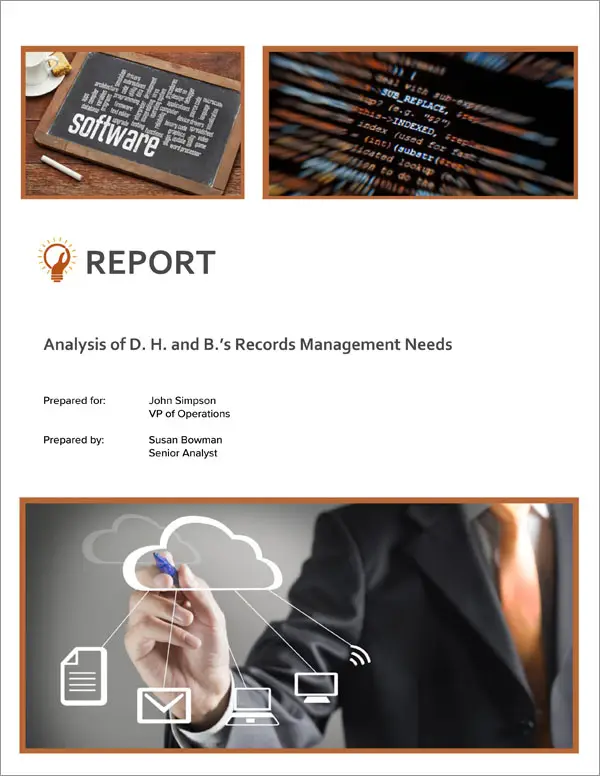
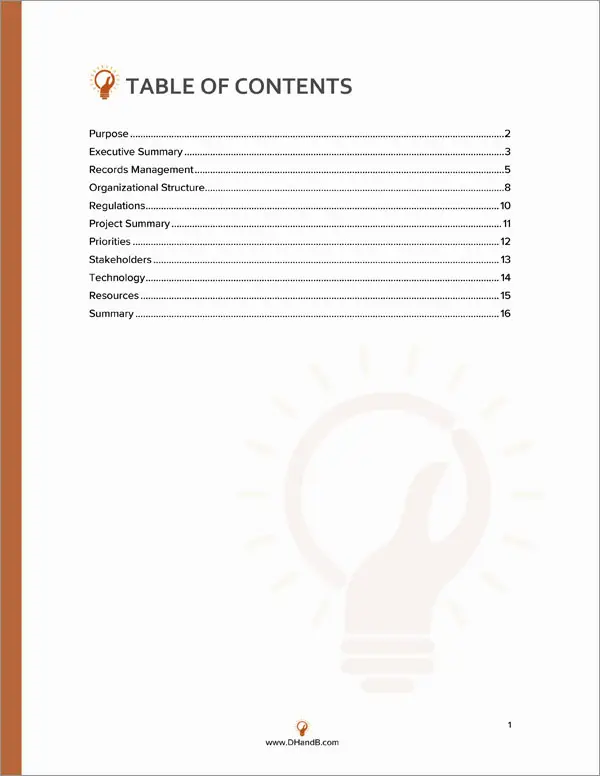
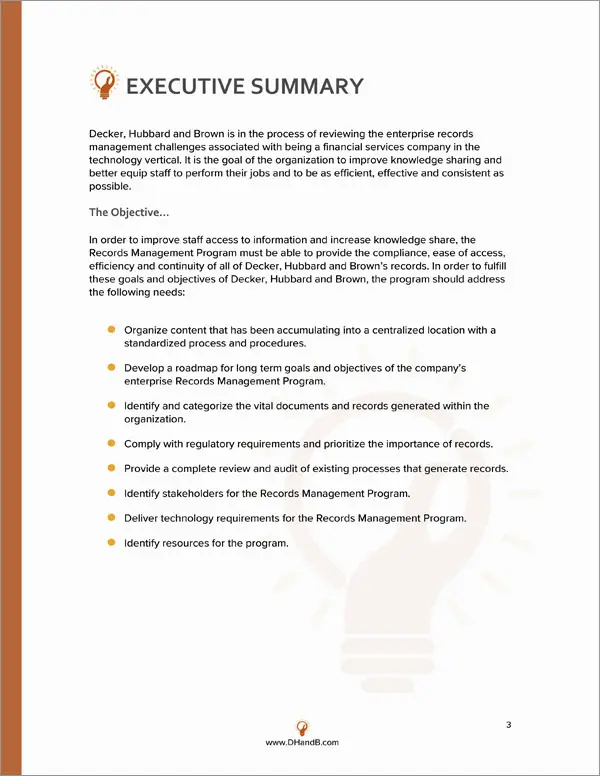
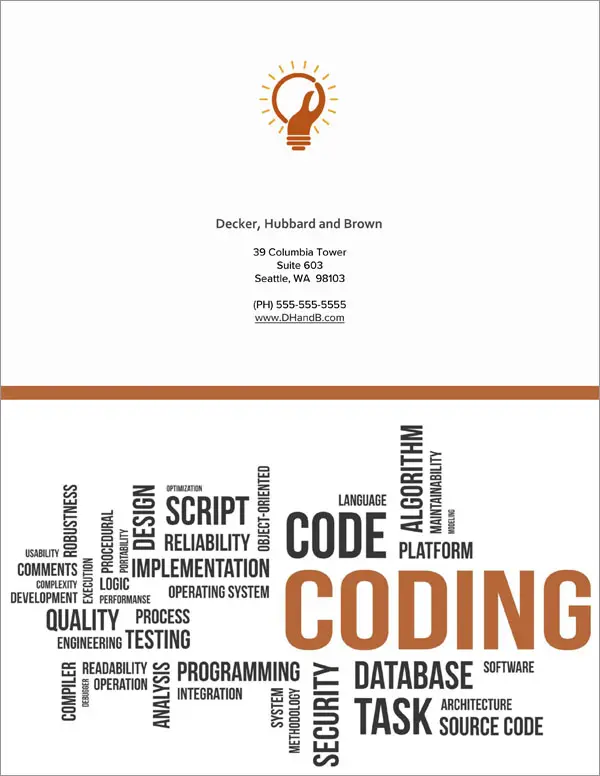
1. Get a Proposal Pack such as Software #2
This sample was created using the design theme Proposal Pack Software #2. You can recreate this same sample using any of our Proposal Pack design themes and have it customized for your business.
We include this sample in PDF and editable Word format chapters that can be customized using the included Wizard software when purchased with a Proposal Pack or the Professional Bundle.
To create your customized proposal using your logo and colors, get Proposal Pack for Any Business. We include this sample in every Proposal Pack.
2. Download and install after ordering
Once you have ordered and downloaded your Proposal Pack you will have all the content you need to get started. If you order the sample as a template you will download the Word document after ordering and edit it in your office software.
3. Set up the included Wizard software
While the Wizard software makes the process more efficient, you can manually assemble your version of this sample using the content provided and just a Word processor. We only include the Wizard software with a Proposal Pack or the Professional Bundle.
4. Import the Quick Start layout titled 'Records Management Analysis Sample Proposal'
The included Proposal Pack Wizard software makes creating a customized version of this document speedy and efficient. The sample content is in Word format documents, so you can also use the sample text without using our Wizard software. Using the Wizard software, you can create custom variations of this template and automate your quotes with the line item database.
This is a good example to follow for anyone proposing technical projects.
Anyone proposing technical projects.
5. Customize the template with your information
You can customize the layout with different chapters, change the order of chapters, import your content and information, change the visual design, edit the text, and more. You have complete control over customizing this sample. Use the Wizard's AI Writer to create personalized content specific to your business and project that can be merged with the sample.
Once finished, the AI Writer's Word-to-PowerPoint converter can transform your proposal, business plan, or other business documents into a PowerPoint slideshow.
Abstract
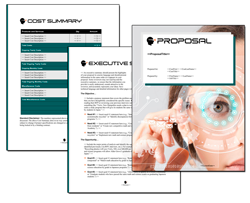
A strong records management program is important for any organization aiming to be a leader in its field, especially in industries like financial services, where compliance, efficiency, and information security are critical. Effective records management analysis allows companies to systematically assess their current document workflows, identify gaps in existing policies, and develop comprehensive strategies for organizing, storing, and protecting business records. By conducting a thorough inventory and analysis of documents, organizations can establish clear policies and file plans, streamline access to vital information, and ensure regulatory requirements are met.
Implementing a centralized records management solution also helps staff with better knowledge sharing, more informed decision-making, and consistent processes across departments. The right approach to records management analysis includes engaging stakeholders, understanding technology requirements, and developing a plan for training and change management, all of which support the organization s long-term goals. With tools that provide customizable templates, AI-powered content generation, and automated quoting, businesses can efficiently create tailored records management proposals that reflect best practices and position themselves as industry leaders.
A well-structured records management analysis not only safeguards an organization s data integrity but also strengthens its position as a leader in regulatory compliance and risk mitigation. For companies facing increasing volumes of both paper and digital information, the ability to implement a standardized and scalable records management program ensures that critical documents are easily retrievable, secure, and disposed of according to a defined retention schedule. This is particularly important for businesses in regulated sectors, where failing to comply with industry standards can result in significant legal and financial consequences.
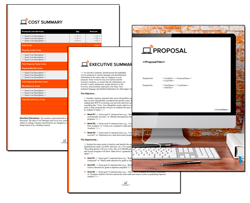
Using a solution like Proposal Kit streamlines the process of developing these important proposals by providing a framework of customizable templates, automated quoting features, and AI-driven writing assistance that saves time and enhances the professionalism of each document. For the target audience - including business owners, department managers, IT leaders, and compliance officers - a records management analysis proposal clarifies the organization s current records status, sets out priorities for improvement, and outlines practical steps for implementation. This clarity can help secure buy-in from stakeholders, allocate resources more effectively, and lay the foundation for ongoing improvement.
Adopting best practices in records management supports business continuity, enables quick response during audits or legal inquiries, and reduces the risk of data breaches. The process also encourages a culture of accountability and continuous improvement, aligning document handling with the organization s objectives. When proposals are created using the advanced Proposal Kit, companies are better equipped to communicate the value of their records management initiatives and demonstrate their commitment to operational excellence and industry leadership.
Beyond regulatory compliance and efficiency, a robust records management analysis supports digital transformation by encouraging organizations to modernize their information infrastructure. As businesses grow, legacy document processes can become fragmented, leading to data silos and inefficiencies that hinder collaboration and innovation. A comprehensive records management proposal identifies these challenges and introduces scalable solutions that integrate with existing business systems, fostering a seamless flow of information across all departments.
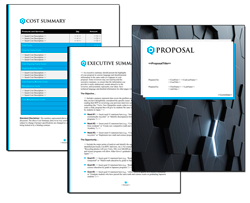
A structured records management program enhances data governance by defining clear roles and responsibilities for document stewardship at every level of the organization. This improves transparency and accountability, making it easier to respond to audit requests, litigation, and regulatory landscapes. For staff, the benefits are tangible: centralized access to up-to-date information reduces time spent searching for records, decreases duplication of effort, and minimizes the risks associated with lost or outdated documents.
In highly competitive industries, organizations that proactively address their records management needs demonstrate foresight and adaptability - key traits of a true leader. Using the Proposal Kit allows organizations to quickly develop proposals that are not only visually professional but also thorough and aligned with the latest industry standards. This accelerates project timelines, supports faster decision-making, and positions the organization to respond confidently to new business opportunities or regulatory changes. Ultimately, investing in records management analysis and using effective proposal development tools enables organizations to protect their intellectual assets, build stakeholder trust, and sustain long-term growth.
Records Management Analysis Sample Proposal - The Narrative
Analysis of D.H. and B.’s Records Management Needs. Decker, Hubbard and Brown is in need of a Records Management Program to organize our corporate documents. This report provides the analysis and assessment of Decker, Hubbard and Brown’s Records Management Program for the creation of content and documenting the processes of the business activities. The purpose of this report is to provide the analysis and assessment of Decker, Hubbard and Brown’s Records Management Program for the creation of content and documenting the processes of the business activities.
Documenting and conducting analysis of the Records Management Program will provide Decker, Hubbard and Brown with the assessment of the current state of the organization’s Information Management Policies and should be taken into consideration before moving forward with any modifications or development and design of a Records Management Program. The report identifies the dependencies between workflow processes and the business actions that generate records and the associated information metadata that needs to be created or captured as part of the Records Program to better understand where the organization is with respect to records management. Decker, Hubbard and Brown is in the process of reviewing the enterprise records management challenges associated with being a financial services company in the technology vertical.
It is the goal of the organization to improve knowledge sharing and better equip staff to perform their jobs and to be as efficient, effective and consistent as possible.
The Objective
In order to improve staff access to information and increase knowledge share, the Records Management Program must be able to provide the compliance, ease of access, efficiency and continuity of all of Decker, Hubbard and Brown’s records. In order to fulfill these goals and objectives of Decker, Hubbard and Brown, the program should address the following needs. Organize content that has been accumulating into a centralized location with a standardized process and procedures. Develop a roadmap for long term goals and objectives of the company’s enterprise Records Management Program.
Identify and categorize the vital documents and records generated within the organization. Comply with regulatory requirements and prioritize the importance of records. Provide a complete review and audit of existing processes that generate records. Identify stakeholders for the Records Management Program.
Deliver technology requirements for the Records Management Program. Identify resources for the program.
The Opportunity
The Records Management Program is an important component for Decker, Hubbard and Brown to continue to be a leader in the financial services industry. The Records Management Program will be able to satisfy Decker, Hubbard and Brown’s needs to be competitive in the financial services market and build a foundation for the records management controls and processes to govern the vast amount of information created, received, and used in the conduct of Decker, Hubbard and Brown’s activities. Design an enterprise Records Management Program to demonstrate the company’s understanding of the nature of its records and compliance with legislation, policies, principles, processes and procedures for managing the organization’s knowledge.
Develop a long term plan for the care and security of the company’s records and to provide fast access to content. Allow personnel to make intelligent and well informed decisions from the most relevant and up-to-date data. Identify the company’s processes and the technologies for best practices of records life cycle management.
The company’s primary focus of records is for the functional areas within the organization that generate high volumes of content and meet the goals of the Records Management Program. A current inventory of Decker, Hubbard and Brown’s documents and records is recommended to define the as-is state and identify departments or business units that have gaps in standards and procedures for Records Management. As part of the formal program assessment, a review of all content in context of the Records Management Program will help Decker, Hubbard and Brown develop policies and procedures for the new program.
The policies and procedures should be authorized and adopted though change management and delivered to the organization with training. The goal of the Records Management Program is to develop policies that clearly identify the sources of content, categories of records, and the appropriate retention period. The group of electronic documents created for developing collateral for the purpose of sales activates to include sales, marketing, training, and projects.
The HR group's documentation of an individual's employment, assessing and directing employee progress toward performance goals, investigating and responding to employee misconduct, grievances and disciplinary matters. The following is a list of Decker, Hubbard and Brown’s current policies dealing with information and records management related matters.
Policy and procedure for managing records
Identify the employee’s responsibilities for storing and deleting paper and electronic documents, including emails and records management requirements.
- Policy for use of organization’s computer equipment
- Identify the responsibility for safeguarding the data on local machines and servers
- File System and Temporary File Shares Policy
- Policy for using a temporary share location and retaining short-lived records
- Conform to security and access-related guidelines
- File Naming and Versioning Procedure
- Version control reduces the risks of using the wrong documents and enhances the ability to secure records and provide better information auditing
- Ensure documents are correct, current, and support productivity though using standards and templates
- Accounting Policy and Procedure
- Accounting policies and procedures for income and expenses
- Handled by bookkeeper, accountant or software such as Quickbooks Online, Simple Start or Pro SAP, or Peachtree Accounting Manage receipts, invoices and canceled checks
- Logo Use and Guidelines Policy and Procedure
- Company branding documents and templates
- Standardize on document creation
- Specific retention periods and standards for documentation surrounding an audit
- Conform to any policy, procedures or guidelines specific to an industry
- Secure FTP Server Policy and Procedure
- Organization of information on the FTP server and purging
- Organize and manage objects placed on the FTP server
- Expense Accounts, Diaries, Log Books, and Other Records
- Policy for travel, car, meals, and entertainment costs
- Meet record keeping guidelines for the management of receipts for an expense, and standardize the written record of the purpose of the expense, the date it was incurred, and other information, depending on the nature of the expense
- Gaps in Records Management Policy and Procedure
For the purposes of the Records Management Program, Decker, Hubbard and Brown will perform a records inventory and catalog all content to create a file plan and retention schedule for the development and maintenance of the Records Management Program. The following outlines Decker, Hubbard and Brown’s organizational structure with the purpose and details of each unit. The purpose or function of each unit in the structure of Decker, Hubbard and Brown will aid in the creation of the File Plan to categorize records, define ownership and locations of content, and aid in defining taxonomy.
Organizational Chart
The following is a list of departments and functions within Decker, Hubbard and Brown.
- Name and Acronym of Business Unit
- Function of Business Unit
- Specific details about business unit content
- The functions relating to the management of projects
- Documents created by project managers and consultants' projects, pre-sales activities, training, support
- The function of managing the workforce
- Documents created for personnel management, regulations, personnel development and on-boarding
The function of managing the production and organization of creating, communicating, delivering, and promoting the organization's mission and goals to customers, clients, partners. The activity of promotion and design elements of the organization.
- Sales Collateral
- Tradeshows
- Campaigns
- Social Media
- Standards
- Templates and internal departments
- Sales
The function of distributing collateral for goods and services in response to acquisition requests and promotion of the organization's products and services. Promoting the organization's products, professional services, and maintaining account activity.
- Call List
- Quotes
- RFP
- Presentations
- Account Activity
- Financial Management
The functions related to the fiscal management of the collection, investment and disbursement of funds. The activity of the expense and administration of debt owed to suppliers and transactions dealing with the billing of goods and services, and administration of debt owed to the business.
- Accounts Payable
- Accounts Receivable
- Checks
- Purchase Orders
- Invoice
Administration Board of Directors
- The functions relating to the management of the organization and its general administration
- The activity of miscellaneous operating records
- Insurance Policies
- Business Planning
- Emergency Documents
- Security Tapes
The following outlines Decker, Hubbard and Brown’s regulatory or legal compliance requirements for managing the documents and records created in the daily activities of running the business. The regulatory environment for Decker, Hubbard and Brown consists of the internal audits and IRS regulations for records management.
Regulatory Environment Elements
- Decker, Hubbard and Brown's internal audit operations, including reports
- IRS-required documents for recordkeeping
- Material safety data sheets MSDS
- Sarbanes- Oxley SOX
- JCAHO Joint Commission on Accreditation of Healthcare Organizations
- HIPAA Health Insurance Portability and Accountability Act
- ISO International Organization for Standardization regulations
Internal Audits
Decker, Hubbard and Brown uses a third-party auditing firm to provide evidence of sound financial reporting and ensure the company is in compliance with laws and regulations.
IRS-Required
Decker, Hubbard and Brown is required to keep business documents supporting federal tax regulations and provide a summary of business transactions. The Records Management Program will include the creation and disposition of the company’s financial records for example, accounting journals, supporting documents, expenses, travel, transportation, entertainment, and taxes.
Material Safety Data Sheet MSDS
Decker, Hubbard and Brown must catalog and maintain MSDS documents. The Occupational Safety and Health Administration OHSA requires that MSDS documents be available to employees in the workplace and to local fire departments and local and state emergency planning officials in the event of an emergency. Part of Decker, Hubbard and Brown’s Records Management Program is to provide online access and management MSDS sheets.
To ensure records are identified and managed in the framework of how Decker, Hubbard and Brown conducts business, a records-based workflow process should be documented and identified. Decker, Hubbard and Brown could benefit from process improvement and workflow automation as a part of the Records Management program to reduce document handling time, minimize double entry, and increase productivity with more relevant search results. The process of creating records within Decker, Hubbard and Brown can be identified by pinpointing the transactions that are worked on during business operations and the workflow process for these procedures.
Attention to the stages of a records life cycle creation, management, and disposition within the workflow and the primary records generated within processes will identify critical and valuable records within the company. For example, many records are generated from the sales order process and project-related deliverables.
Sales Order Process for Goods and Services
The sales order process involves multiple people and departments and is an important part of workflow processes. The sales person works with the customer to procure an order, creating records such as quotes, sales charters, purchase orders, inventory, and order fulfillment documents.
Project-Related Deliverables
The key project documents in the sales and services cycle include the Project Charter, Project Plan, and Project Schedule. The services process involves multiple people and departments and most of the documents are stored on a network file share on Server A. Documents and records are triggered from different tasks throughout the project such as deliverables, resource assignments, change control, billing, and support.
The Records Management Program Analysis identified the following priorities as necessary to design and implement a Records Management Program for the organization. Priority #1 - Review and Update Policies and Procedures – Many of the policies and procedures for Decker, Hubbard and Brown’s management of the corporate records need to be updated. Clearly defined rules and responsibilities for governance and maintenance of corporate knowledge need to be created.
Priority #2 - Perform Inventory – For the company to design an Information Management Policy for the Records Management Program, the specific information that is stored must be identified and categorized to develop a file plan. In order to generate the file plan, an inventory must be performed. Priority #3 - Design Taxonomy – Design a content classification for the nomenclature of Decker, Hubbard and Brown's records. Priority #4 - Develop File Plan and Retention Schedule – The file plan categorizes and lists all the information for each type of content that needs to be stored and managed.
The retention schedule applies disposition rules and instructions for each record category. Priority #5 – Develop Central Records Repository – Enterprise Records Management Program development. Stakeholders are vital to the Records Management Program for it to be successful, and it is critical that they understand its importance to the organization and to their particular scope of influence.
Senior Management must be involved and they will be providing the resources required, including time to research, design and implement the plan along with any money required to buy necessary technology and expertise. Senior Management Senior Management has the overall responsibility for the success of the organization and are the ones setting its strategic goals and objectives.
Business Unit Managers
Business Unit Managers are individuals responsible for the overall operational effectiveness of their offices, departments, functions, and other business units.
Legal
The Legal team is responsible for responding to legal, regulatory, or audit-related requests for information such as contracts, HR matters, and subpoenas. Record Manager. The Record Manager will oversee administrative tasks relating to records management, such as classification of records, maintenance of the file plan, and the actual disposition of records at the end of the records lifecycle. IT should have oversight on the proposed policies and procedures to determine if they can be technically implemented and ensure IT standards are followed. Users The users are the ones who will be using the system as part of daily work activities.
Decker, Hubbard and Brown uses the following technology for the current Records Management Program.
Physical Records Management
Paper documents, binders, and historical documents are cataloged and stored in an Access database.
Enterprise Content Management Software
Decker, Hubbard and Brown intends to use Microsoft SharePoint to Manage Records. Company Technology Standards Decker, Hubbard and Brown uses Microsoft operating systems and SQL databases to support the technological environment. Developing, implementing, and supporting an effective Records Management Program requires resources that completely understand the business and the types of documents created by the company.
The following internal resources will be needed for the Records Management Program.
Internal Resources
Information stewards or knowledge workers from within the organization who are subject matter experts of types of documents that are created within the organization. Records Manager for managing the process and updating the file plan for the organization. Information technology personnel who are familiar with the enterprise architecture and types of electronic documents the organization creates and receives.
External Resources
Lawyers, information security experts, consultants, and regulatory experts knowledgeable in the requirements for document retention. Bookkeeper - if appropriate. Contractors, system integrators or third-party resources who create content and recommendations for the organization.
Decker, Hubbard and Brown’s Records Management Program will provide benefits with increased productivity by providing organized and predictable access to critical business records throughout the organization. The analysis of the current Records Management Program shows that the following areas need to be addressed in order to reach Decker, Hubbard and Brown’s goals. Perform an inventory of all of the organization's documents to locate, categorize, identify duplicates, and standardize. Develop a file plan from the inventory that organizes the organization's documents in a hierarchical functional level to apply retention.
Centralize and consolidate records and use standardized metadata to increase search capabilities. Define document access and security rights for the enterprise. Define roles and responsibilities for managing the Records Management Program.
Enhance records management policies and procedures. Administer and enforce the policies, procedures and guidelines for the Records Management Program. Develop education and training that complements the Records Management Program to conform to Decker, Hubbard and Brown’s mission, goals, and management processes.
Goals
Implement a central records management software system. Create consistency across business units for records management operations. Demonstrate compliance for litigation and or government investigations. Better tracking of storage costs and use of documents.
Organizing and standardizing on a comprehensive information plan that includes the management of content lifecycles will provide additional operational and tactical benefits in the form of reduced man-hours for processing and reduced risk of non-compliance and audit for regulatory requirements.
 What Our Clients Say
What Our Clients SayI found this purchase online while searching for a way to easily write business documents. Proposal Pack has turned my business proposals into professional looking documents. I highly recommend this software."
Shop High Point
There are 200 complete sample proposals including this one in each Proposal Pack
The following related samples are also included in Proposal Pack:
These template layouts are related to this sample
The following related templates are also included in Proposal Pack with this sample:
- Electronic Medical Record System Proposal
- Business Case Document
- Cloud Services Consulting Proposal
- Electronic Records Management Proposal
- IT Product and Service Sales Proposal
- Business Services and Consulting Proposal
- Cloud-based Asset Tracking Project Proposal
- Records Management Survey Analysis
- Software Automation Proposal
- Cloud Computing Services Proposal
- IT Disaster Recovery Services Proposal
- Project Management Consulting Services Proposal
- Business Complaint And Solution Proposal Template
- FinTech Cost Benefit Analysis Proposal Template
- Digital Product Sales Proposal Template
- IT Development Proposal Template
- IT Support Services Proposal Template
- Information Technology Proposal Template
- CRM Implementation Proposal Template
- Cloud Computing Project Proposal Template
Length of Sample
18 PagesThere are thousands of chapters to choose from in Proposal Pack. This sample uses the following set of Proposal Pack chapter templates: Title Page, Table of Contents, Executive Summary, Purpose, Records Management, Priorities, Regulations, Technology, Resources, Project Summary, Summary, Stakeholders, Organizational Structure, Back Page.
This sample illustrates how to write the following types of proposals
- Technical proposal
- Project pitch proposal
- Internal company proposal
- Business document, study, plan, report
- IT, software, hardware proposal
- Records Management (RIM, ERM) material
- Many other types of proposals
Samples can be created in any Proposal Pack design theme
This sample was created with Proposal Pack Software #2. To change the visual look purchase any Proposal Pack and this sample will be created in that design theme.
Out of the over 501 Proposal Packs available these designs are also popular for this type of proposal and this sample proposal is also included in every Proposal Pack:
Photo Design Proposal Packs
 Proposal Pack Computers #5
Proposal Pack Computers #5 Proposal Pack Computers #6
Proposal Pack Computers #6 Proposal Pack Contemporary #19
Proposal Pack Contemporary #19 Proposal Pack Software #1
Proposal Pack Software #1Line Art Design Proposal Packs
 Proposal Pack Computers #1
Proposal Pack Computers #1 Proposal Pack Multimedia #1
Proposal Pack Multimedia #1 Proposal Pack Multimedia #2
Proposal Pack Multimedia #2 Proposal Pack Multimedia #3
Proposal Pack Multimedia #3 Proposal Pack Multimedia #4
Proposal Pack Multimedia #4 Proposal Pack Tech #1
Proposal Pack Tech #1 Proposal Pack Tech #4
Proposal Pack Tech #4 Proposal Pack Tech #6
Proposal Pack Tech #620% Off Discount
![]() Add To Cart This Word Template
Add To Cart This Word Template
 Add To Cart Proposal Pack Software #2
Add To Cart Proposal Pack Software #2
 Add To Cart Proposal Kit Professional Bundle
Add To Cart Proposal Kit Professional Bundle
 4.7 stars, based on 848 reviews
4.7 stars, based on 848 reviewsFrequently Asked Questions
How do I customize this sample to fit my specific project or business?
If you purchase this sample as a static template, it will be an editable Word format document; otherwise, if you buy a Proposal Pack or the Professional bundle, you can build a more customized editable Word document version of it using the included Wizard software. You can replace the sample information with your own, adjust the text to match your company's tone and style, and modify sections to include project-specific details. The included AI Writer will also customize the content for you.
Can I use multiple sample proposals for different types of projects?
You can purchase multiple samples as individual Word templates or all 200 samples are included in every Proposal Pack and Proposal Kit Professional, which is a much better deal. The Proposal Kit offers sample proposals for various industries and project types. You can select and customize different sample proposals to suit each unique project. This flexibility allows you to create tailored proposals for other clients or projects.
How can I integrate my branding into this sample?
While this sample is an editable Word document, depending on the level of custom branding needed, consider the Proposal Kit Professional, which includes the branding features in the Wizard software that let you create custom-branded design themes more effectively. Start by incorporating your company's logo on the cover page, as well as in the headers and footers of the document. Next, adjust the color scheme of the proposal to match your brand colors. Change the fonts in the proposal to align with your brand's standard fonts. Including branded graphics that reflect your brand's style will further enhance the proposal. Additionally, ensure that the text within the proposal maintains a tone and voice consistent with your brand's communication style. By integrating these elements, your proposal will reinforce your brand identity.
How do I ensure my proposal stands out and wins the client?
To ensure your proposal stands out:
- Personalize the content: Address the client's needs, challenges, and goals to make the proposal unique.
- Highlight your value proposition: Communicate what sets your business apart and how to deliver superior results.
- Use professional design elements: Incorporate visuals, charts, and graphs to enhance the presentation and make it more engaging.
- Proofread and edit: Ensure the proposal is error-free and well-organized. A polished, professional document reflects your attention to detail and professionalism.
What should I do if I need help understanding or modifying a section of this sample?
If you need help understanding or modifying a section of this sample, refer to the detailed instructions provided. Additionally, Proposal Kit includes customer support and resources such as tutorials and videos to assist you. Consulting with a colleague or a professional in your industry can also be beneficial if further clarification is needed. Asking an AI tool can also provide valuable insights for immediate needs. You can load this sample into the Wizard software and let its AI Writer customize the pages for you.
 Ian Lauder has been helping businesses write their proposals and contracts for two decades. Ian is the owner and founder of Proposal Kit, one of the original sources of business proposal and contract software products started in 1997.
Ian Lauder has been helping businesses write their proposals and contracts for two decades. Ian is the owner and founder of Proposal Kit, one of the original sources of business proposal and contract software products started in 1997.By Ian Lauder
 Published by Proposal Kit, Inc.
Published by Proposal Kit, Inc.


 Cart
Cart
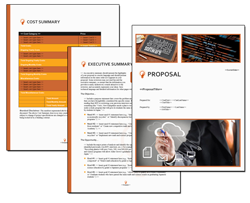

 Facebook
Facebook YouTube
YouTube Bluesky
Bluesky Search Site
Search Site